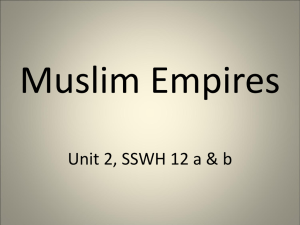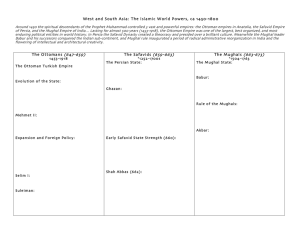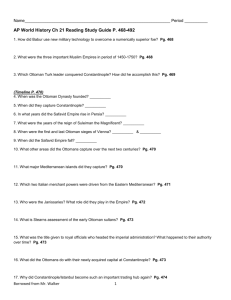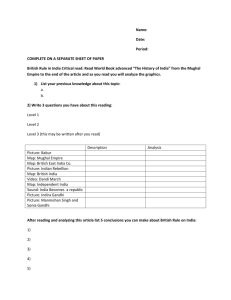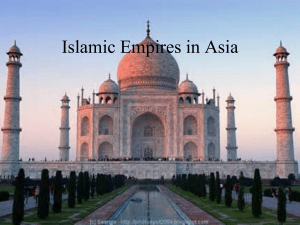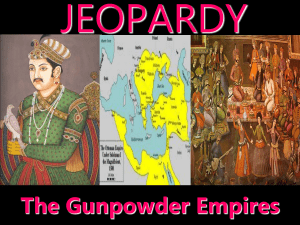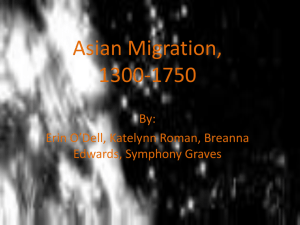Empires of Asia 1450-1750
advertisement
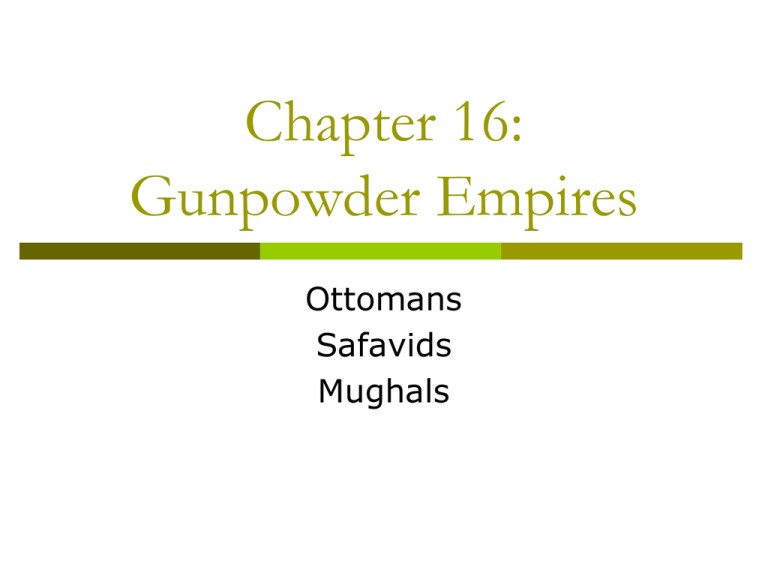
Chapter 16: Gunpowder Empires Ottomans Safavids Mughals Empire Builders, 1683 Ottoman Empire Rise of Empires: Ottoman Osman (1258-1326) Mehmed II (1432-1481) Unites Turks against Mongols Conquered Byzantine Empire Renamed city Istanbul Absolute monarchy; centralized state Methods Ghazi (Muslim religious warriors) Gunpowder Janissaries Devshirme—”Blood Tax” Political Systems: Ottoman Sultans were at the head of the empire The position of sultan was hereditary Many deaths among family members took place because of this Empire at its height under Suleyman Reigned 1520-1566 Conquered lands in Europe, Asia, Africa Mother was Christian Came to power through murder of brothers Conquered Syria, Holy Land, Egypt Conquered Hungary, Croatia, Rumania Siege of Vienna in 1529 - failed Built powerful navy to rule Mediterranean Encouraged development of arts Beautified Constantinople with mosques Social Systems: Ottoman Social Hierarchy Warrior aristocracy become landed elite Merchants and artisans Guilds Trade controlled by Jews and Christians Peasants face heavy burdens from landowners Slaves (ghulam) Christian males 8-15 were conquered and trained in palace school for work Gender Roles Women subordinate to fathers and husbands Few scholarly or artistic opportunities Seclusion and veiling were imposed on women of all classes Elite women influence politics Hurrem Sultan Could participate in trade and moneylending Economic Systems: Ottoman Timar system Askeri was given a share of the agricultural taxes of a designated region Gradually became hereditary Timar was not feudalism Usually consisting of several villages In return for military service as cavalryman, assisted in provincial government They were exempt from taxation. Timar-holder did not dispense justice (Sultan did) Central government was active and crucial Timar more like Japanese shogun system Tahrir The tahrir took place when a new area was conquered Team of officials surveyed, recorded by sanjak Names of all adult male farmers All sources of wealth in the area Their yields and the taxes paid on them Religious Systems: Ottoman Millet System Each millet was headed by its own religious dignitary Heads of millet were responsible to Turkish sultan Advised sultan on affairs in the community Was punished by sultan for problems of the community Each community was responsible for Chief rabbi in the case of the Jews Patriarchs for the Greek Orthodox, Armenian communities The allocation and collection of its taxes Its educational arrangements Internal legal matters pertaining to marriage, divorce, inheritance In the pre-modern Middle East Muslims were NOT ruled by millets, they were ruled by Quran Muslims were tolerant of other religious Culture: Ottoman Rebuilt Constantinople (Istanbul) Coffee Houses Suleymaiye (Blue) Mosque Built Aqueducts Center of social life Read poetry & have scholarly discussions Architecture Mimar Sinan compared to Michelangelo Blue Mosque, Istanbul Decline of Empires: Ottoman The problems began with Selim II. The training of officials declined. Members of the elite were busy making their own fortunes, so local government grew more corrupt and taxes rose. Wars depleted the imperial treasury. Biggest problem was the influence of Western Europe. Clothes, furniture, tobacco and coffee were introduced. Some sultans tried to fight the trends of Western Europe. One outlawed tobacco and coffee. If he caught anyone taking part in immoral or illegal behavior, he had them immediately executed Ottoman conservatives Resisted innovations like the telescope, printing press Resisted western military innovations, industrialization Discouraged merchants, commercialism Safavid Empire Rise of Empires: Safavid Turkish conquerors of Persia and Mesopotamia Founder Shah Ismail (reigned 1501-1524) Under Ismail, the Safavid took control of much of Iran and Iraq Claimed ancient Persian title of shah Battle of Chaldiran (1514) Sunni Ottomans persecuted Shiites within Ottoman empire Qizilbash considered firearms unmanly; lost battle Political Systems: Safavid Shah Abbas the Great (1588-1629) He usurped the throne from his father and imprisoned him. He later killed the man who helped him get the throne. Revitalized the Safavid empire Modernized military Centralized administration New capital at Isfahan Permitted European merchants and missionaries Sought European alliances To help attack the Ottoman Turks and regain lost lands Couldn’t keep all territorial gains, but did get Azerbaijan back Social Systems: Safavid The role of the shah was that of a king. The social structure was: Shah Bureaucracy and landed classes Common people Women and Religion When Shah Abbas died, religious orthodoxy, a pressure to conform to traditional religious beliefs, increased. Women were to give up freedom for a life of seclusion and the wearing of the veil. Economic Systems: Safavid Long-distance trade was most important Shared sections of east-west trade routes with the Ottomans early on in empire Offered silk, carpets, and ceramics to Europeans Religious System: Safavid The official religion was Shia Islam The Shiites supported the shahs at first (Ismail was a Shi’ite Muslim). They sent preachers to different areas to convert members of the Ottoman Empire. Followers were qizilbash (or "Red Hats") Culture: Safavid Isfahan was the jewel of the Safavids it is still that for modern-day Iran The “queen of Persian cities” Central mosque, shown here Artistic Achievements Silk weaving flourished Carpet weaving flourished more and Persian rugs are still prized today. Riza-i-Abbasi is the most famous artist of this time. He made beautiful works about simple subjects such as oxen plowing, hunters, and lovers. They used soft colors and flowing movement in painting. Decline of Empires: Safavid Religious Reasons Military decline Shiite leaders urged shahs to persecute Sunnis, Sufis Non-Muslims lost many protections Imported European weapons but never made their own Arsenals outdated; tactics outdated; systems outdated Rise of Banditry, Piracy In countryside, many poor peasants took to banditry On seas, many ports and merchants too to piracy Trade disrupted, made Europeans mad, who often retaliated Mughal Empire Babur Akbar the Great Rise of Empires: Mughal Babur (1482-1530) Traced descent from Mongols Not motivated by religious fervor Founder of Mughal ("Mongol") dynasty in India Central Asian Turks invaded India and seized Delhi in 1526 By 1530, Mughal empire embraced most of India Political Systems: Mughal Akbar (reigned 1556-1605) A brilliant, charismatic ruler Created centralized, absolutist government Encouraged religious tolerance between Muslims and Hindus Eliminated head tax on Hindus, banned sati Aurangzeb (1659-1707) Expanded the empire to almost the entire Indian subcontinent Revoked policies of toleration: Hindus taxed, temples destroyed His rule troubled by religious tensions and hostility Arrival of Europeans: permitted them to trade, establish bases Social Systems: Mughal Women and marriage Women and society Encouraged widow remarriage Discouraged child marriage Outlawed sati Discouraged female seclusion Women were warriors and advisors in political matters. They could own land and do business. Special market days for women. Women and Hinduism The isolation of women was practiced in upper class Hindu families. A lot of Hindu practices went unchanged by Mogul rule Economic Systems: Mughal Mughal empires less attentive to foreign or maritime trading Mughals permitted stations for English, French, and Dutch Europeans gradually excluded Indian influence Religious Systems: Mughal Religious diversity and tolerance under Akbar Advocated “divine faith” called Din I‘-ilahi Emphasized loyalty to emperor Catholic missionaries welcomed at court of Akbar Sikhism Founded by Guru Nanak (1469-1539) Blend of Islam & Hinduism Personal salvation through disciplined, personal meditation on God Culture: Mughal Architecture Fatehpur Sikri, Mughal capital, created by Akbar Combined Islamic style with Indian elements Site abandoned because of bad water supply Taj Mahal, exquisite example of Mughal architecture Shah Jahan built it for his favorite wife, Mumatz Mahal. It combines Persian, Ottoman, Indian, and Islamic styles. Miniature painting flourished in Iran Decline of Empires: Mughal Aurangzeb’s policies deterred the Hindus Rise of Sikhs Rise of Christians with coming of Europeans The British were the final straw. Sir Robert Clive became the chief representative of the British East India Company. He took control of Indian trade by taking Bengal. The BEIC could now tax the lands surrounding Calcutta. The Indians practiced guerilla warfare against the British. The British moved inland. Trade brought money to the British. The British were in India to stay.
